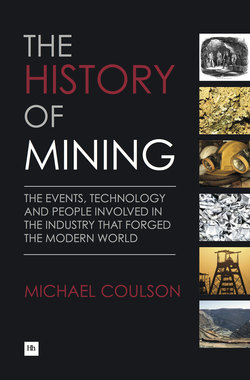Читать книгу The History of Mining - Michael Coulson - Страница 28
На сайте Литреса книга снята с продажи.
Оглавление12. South America
Before the coming of the Spanish in the Middle Ages the areas that are now known as Latin, Central and South America were populated by a variety of civilisations that, because of the colour of their skin, some speculate may have made their way from Asia (as described in the previous section) many millennia before over the land bridge that existed across the Bering Strait, and then spread out east and south. Others may have taken a sea route from Asia going southeast on the prevailing Pacific currents leading them eventually to the shores of central and southern America.
Today South America is well known for hosting a wide array of metals and minerals, both industrial like copper and precious like gold, but its historic tradition was mainly associated with precious metals. Ancient civilisations in South America such as the Chavin and Mochican, were capable of building sophisticated stone structures for living and worshiping in. They also had organised farms and had acquired the skill to work precious metals – gold and silver – into the most intricate and beautiful objects. Interestingly, despite these skills with precious metals, it appears that the Iron Age did not come to South America until the arrival of the Spanish conquistadors with their steel weapons in the 16th century AD.
Although there are many gold mines in production in South America today there is little evidence of ancient gold mines as one might find, for example, in Egypt or Spain. However, the importance of gold metalworking and the quality of the objects found suggests that gold was mined, perhaps extensively, by these ancient civilisations, and certainly centuries later the Conquistadors found more than enough gold objects to satisfy their lust for the metal. It is also the case that the Spaniards themselves did not find gold mines; the gold booty they took back to Europe from their conquests was simply the ancient artefacts that they acquired from the indigenous people.
So if the source of the gold used by South American goldsmiths did not come from open pit and underground mines where did it come from? The most likely answer is that the gold was alluvial and had been naturally scoured out of rich deposits high up in the Andes over millennia, and washed down to lower levels where perhaps large nuggets of pure gold caught the eye of local inhabitants. It is not a large jump to where ancient craftsmen, intrigued by the beauty of the gold, started to fashion items of jewellery and plate from a metal that they would have found easy to work due to its softness. It is also likely that the basic furnaces, which they would have used to make molten gold for the moulds of the objects they were to work on, have simply disappeared over time.
There is also a theory that the Incas, who were fine stonemasons, may have developed an extraordinarily advanced technology to cut stones to very high specifications. It is suggested that huge gold sheets that the conquistadors found were used to concentrate sunlight rays to create a source of solar energy powerful enough to cut stone. Unfortunately, though the Incas may well have developed this industrial-type technology they did not have the technology to record the process – i.e. paper and ink.
Chile
There is an old mining saying that the most likely place to find a mine is where one existed in the past. Therefore, it is perhaps not surprising that evidence was uncovered of mining around 500 BC at the giant Chuquicamata copper mine in northern Chile. Of particular interest were remains uncovered when the current mine was being explored and then developed in the late 19th and early 20th centuries. A number of well-preserved hammers were found, as were the remains of a body of an ancient miner and a basket of copper ore.
Radiocarbon dating suggested that these finds were from around the 3rd century AD, or perhaps a little earlier than that. Unfortunately, although some ideas were formed as to where mining took place, at Chuquicamata no actual workings were uncovered, perhaps indicating that ancient mining was confined to surface shows of copper. Although Chile was later to become a sizeable gold producer in the 18th and early 19th centuries, there is evidence of some gold mining in ancient times, and a little more during the period of the Inca occupation of parts of northern Chile.
Peru
In 2004/05 a major ancient iron mine was excavated by archaeologists from Purdue University in the US, in an area of Peru a couple of hundred miles south of Lima, where centuries ago the Nasca civilisation lived between the 1st and 7th centuries AD. The old mine was in the form of a 700 cubic metre chamber close to a current ochre mine. The chamber would have been dug out using hand tools to break and then scour out the ore. It has been calculated that the ancient mine produced around 3,700 tonnes of haematite over 1,400 years of operation. This is of course a tiny amount by modern mining standards but the Nasca people were artistic and the haematite when crushed and treated would probably have been used for painting, not for producing metal on an industrial scale.
